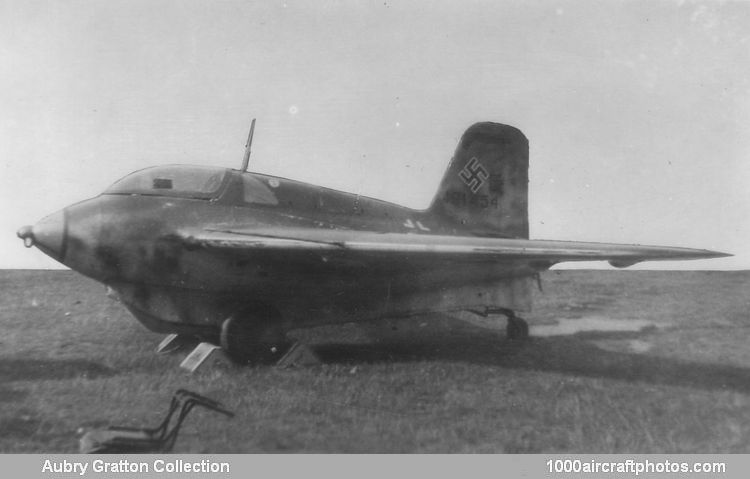10/31/2017. Remarks by Johan Visschedijk: "Evolved from the Me 163 A rocket-propulsion research aircraft designed by Dr. Alexander M. Lippisch, the Me 163 B, which retained no more than the basic configuration of its predecessor, was conceived as a single-seat target defense fighter. Of radical design, the Me 163 B featured a constant 22.3 deg of wing sweepback at quarter chord, lacked horizontal tail surfaces and utilized a jettisonable twin-wheel dolly for take off and a retractable skid for landing. Six prototypes and seventy pre-series aircraft were ordered all being assigned Versuchs (test) numbers.
The first prototype, the Me 163 B V1, was completed in April 1942, but the first Walter HWK R II-211 rocket motor intended to power the fighter was delayed, the first powered flight (Me 163 B V2) taking place on June 23, 1943. The bi-fuel rocket motor (which became the HWK 509A-1 in production form) possessed a max thrust of 3,750 lb (1,700 kg) delivered for 7.5 min.
The pre-series aircraft, the Me 163 Ba-1, carried an armament of two 0.787 in (20 mm) MG 151 cannon whereas the series Me 163 B-1a had two 1.18 in (30 mm) MK108 cannon. The first production aircraft, which had been unofficially named Komet (Comet), was accepted by the Luftwaffe in May 1944, and a total of 279 was delivered. The service record of the Me 163 B was to prove dismal, 80% of attrition resulting from take off or landing accidents and 15% being attributable to fire in the air or loss of control in a dive.
A proposed development of the basic design was the Me 163 C. This was to have differed from the Me 163 B primarily in having an HWK-509C rocket motor with an auxiliary cruise chamber with which powered endurance was to have been increased to 19 min. Armament was two 1.18 in (30 mm) MK 103 and two MK 108 cannon, the fuselage was lengthened by 35.4 in (90 cm) and an all-round vision canopy was provided. Construction of four Me 163 C prototypes began in January 1943, with partial testing scheduled to commence April 1944, full-scale testing in August 1944, and completion of testing by February 1945. In the event, no example of the Me 163 C was completed and flown.
Coded 'Yellow 11' the aircraft pictured above served with Jagdgeschwader JG 200 at Husum in Northern Germany, where it was surrendered near the end of WW II. It was taken to the UK as a war prize and it received the Air Ministry code 204, and moved around in the UK, including the display in London, before it was shipped to Canada aboard the SS Manchester Commerce on August 28, 1946. Reportedly it was scrapped at Arnprior, Ontorio, in 1957."
